- Home
- Neal Stephenson
Mother Earth Mother Board Page 5
Mother Earth Mother Board Read online
Page 5
The Elbe has its own tugboat, the Ocean East, staffed with an Indonesian crew. Relations between the two vessels have been a bit tense because the Indonesians butchered and ate all of the Elbe's laying hens, terminating the egg supply. But it all seemed to have been patched up when we were there; no one was fretting about it except for the Elbe's rooster. When the Elbe is more than half a kilometer from shore, Ocean East pulls her along by means of a cable. The tug's movements are controlled from the Elbe's bridge over a radio link. Closer to shore, the Elbe drops an anchor and then pulls itself along by winching the line in. She can get more power by using the Harbormaster thruster units mounted on each of her ends. But the main purpose of these thrusters is to provide side propulsion so the barge's movements can be finely controlled.
The nerve center of the Elbe is a raised, air-conditioned bridge jammed with the electronic paraphernalia characteristic of modern ships, such as a satellite phone, a fax machine, a plotter, and a Navtex machine to receive meteorological updates. Probably the most important equipment is the differential GPS system that tells the barge's operators exactly where they are with respect to the all-important Route Position List: a series of points provided by the surveyors. Their job is to connect these dots with cable. Elbe's bridge normally sports four different computers all concerned with navigation and station-keeping functions. In addition to this complement, during the Tong Fuk cable lay, Dave Handley was up here with his laptop, taking down data important to FLAG, while the representatives from AT&T and Cable & Wireless were also present with their laptops compiling their own data.
Hey, wait a minute, the hacker tourist says to himself, I thought AT&T was the enemy. What's an AT&T guy doing on the bridge of the Elbe, side-by-side with Dave Handley?
The answer is that the telecom business is an unfathomably complicated snarl of relationships. Not only did AT&T (along with KDD) end up with the contract to supply FLAG's cable, it also ended up landing a great deal of the installation work. Not that many companies have what it takes to manage an installation of FLAG's magnitude. AT&T is one of them and Nynex isn't. So it frequently happens at FLAG job sites that AT&T will be serving as the contractor, making the local contacts and organizing the work, while FLAG's presence will be limited to one or two reps whose allegiance is to the investors and whose job it is to make sure it's all done the FLAG way, as opposed to the AT&T way. As with any other construction project from a doghouse on upward, countless decisions must be made on the site, and here they need to be made the way a group of private investors would make them - not the way a club would.
If FLAG's investors spent any time at all looking into the history of the cable-laying business, this topic must have given them a few sleepless nights. The early years of the industry were filled with decision making that can most charitably be described as colorful. In those days, there were no experienced old hands. They just made everything up as they went along, and as often as not, they got it wrong.
Thomson and Whitehouse
As of 1861, some 17,500 kilometers of submarine cable had been laid in various places around the world, of which only about 5,000 kilometers worked. The remaining 12,500 kilometers represented a loss to their investors, and most of these lost investments were long cables such as the ones between Britain and the United States and Britain and India (3,500 and 5,600 kilometers, respectively). Understanding why long cables failed was not a trivial problem; it defeated eminent scientists like Rankine and Siemens and was solved, in the end, only by William Thomson.
In prospect, it probably looked like it was going to be easy. Insulated telegraph wires strung from pole to pole worked just as one might expect, and so, assuming that watertight insulation could be found, similar wires laid under the ocean should work just as well. The insulation was soon found in the form of gutta-percha. Very long gutta-percha-insulated wires were built. They worked fine when laid out on the factory floor and tested. But when immersed in water they worked poorly, if at all.
The problem was that water, unlike air, is an electrical conductor, which is to say that charged particles are free to move around in it. When a pulse of electrons moves down an immersed cable, it repels electrons in the surrounding seawater, creating a positively charged pulse in the water outside. These two charged regions interact with each other in such a way as to smear out the original pulse moving down the wire. The operator at the receiving end sees only a slow upward trend in electrical charge, instead of a crisp jump. If the sending operator transmitted the different pulses - the dots and dashes - too close together, they'd blur as they moved down the wire.
Unfortunately, that's not the only thing happening in that wire. Long cables act as antennae, picking up all kinds of stray currents as the rotation of the Earth, and its revolution around the sun, sweep them across magnetic fields of terrestrial and celestial origin. At the Museum of Submarine Telegraphy in Porthcurno, Cornwall (which we'll visit later), is a graph of the so-called Earth current measured in a cable that ran from there to Harbor Grace, Newfoundland, decades ago. Over a period of some 72 hours, the graph showed a variation in the range of 100 volts. Unfortunately, the amplitude of the telegraph signal was only 70 volts. So the weak, smeared-out pulses making their way down the cable would have been almost impossible to hear above the music of the spheres.
Finally, leakage in the cable's primitive insulation was inevitable. All of these influences, added together, meant that early telegraphers could send anything they wanted into the big wire, but the only thing that showed up at the other end was noise.
These problems were known, but poorly understood, in the mid-1850s when the first transatlantic cable was being planned. They had proved troublesome but manageable in the early cables that bridged short gaps, such as between England and Ireland. No one knew, yet, what would happen in a much longer cable system. The best anyone could do, short of building one, was to make predictions.
The Victorian era was an age of superlatives and larger-than-life characters, and as far as that goes, Dr. Wildman Whitehouse fit right in: what Victoria was to monarchs, Dickens to novelists, Burton to explorers, Robert E. Lee to generals, Dr. Wildman Whitehouse was to assholes. He achieved a level of pure accomplishment in this field that the Alfonse D'Amatos of our time can only dream of. The only 19th-century figure who even comes close to him in this department is Custer. In any case, Dr. Edward Orange Wildman Whitehouse fancied himself something of an expert on electricity. His rival was William Thomson, 10 years younger, a professor of natural philosophy at Glasgow University who was infatuated with Fourier analysis, a new and extremely powerful tool that happened to be perfectly suited to the problem of how to send electrical pulses down long submarine cables.
Wildman Whitehouse predicted that sending bits down long undersea cables was going to be easy (the degradation of the signal would be proportional to the length of the cable) and William Thomson predicted that it was going to be hard (proportional to the length of the cable squared). Naturally, they both ended up working for the same company at the same time.
Whitehouse was a medical doctor, hence working in the wrong field, and probably trailed Thomson by a good 50 or 100 IQ points. But that didn't stop Whitehouse. In 1856, he published a paper stating that Thomson's theories concerning the proposed transatlantic cable were balderdash. The two men got into a public argument, which became extremely important in 1858 when the Atlantic Telegraph Company laid such a cable from Ireland to Newfoundland: a copper core sheathed in gutta-percha and wrapped in iron wires.
This cable was, to put it mildly, a bad idea, given the state of cable science and technology at the time. The notion of copper as a conductor for electricity, as opposed to a downspout material, was still extraordinary, and it was impossible to obtain the metal in anything like a pure form. The cable was slapped together so shoddily that in some places the core could be seen poking out through its gutta-percha insulation even before it was loaded onto the cable-laying ship. But venture capitalists back the
n were a more rugged - not to say crazy - breed, and there can be no better evidence than that they let Wildman Whitehouse stay on as the Atlantic Telegraph Company's chief electrician long after his deficiencies had become conspicuous.
The physical process of building and laying the cable makes for a wild tale in and of itself. But to do it justice, I would have to double the length of this already herniated article. Let's just say that after lots of excitement, they put a cable in place between Ireland and Newfoundland. But for all of the reasons mentioned earlier, it hardly worked at all. Queen Victoria managed to send President Buchanan a celebratory message, but it took a whole day to send it. On a good day, the cable could carry something like one word per minute. This fact was generally hushed up, but the important people knew about it - so the pressure was on Wildman Whitehouse, whose theories were blatantly contradicted by the facts.
Whitehouse convinced himself that the solution to their troubles was brute force - send the message at extremely high voltages. To that end, he invented and patented a set of 5-foot-long induction coils capable of ramming 2,000 volts into the cable. When he hooked them up to the Ireland end of the system, he soon managed to blast a hole through the gutta-percha somewhere between there and Newfoundland, turning the entire system into useless junk.
Long before this, William Thomson had figured out, by dint of Fourier analysis, that incoming bits could be detected much faster by a more sensitive instrument. The problem was that instruments in those days had to work by physically moving things around, for example, by closing an electromagnetic relay that would sound a buzzer. Moving things around requires power, and the bits on a working transatlantic cable embodied very little power. It was difficult to make a physical object small enough to be susceptible to such ghostly traces of current.
Thomson's solution (actually, the first of several solutions) was the mirror galvanometer, which incorporated a tiny fleck of reflective material that would twist back and forth in the magnetic field created by the current in the wire. A beam of light reflecting from the fleck would swing back and forth like a searchlight, making a dim spot on a strip of white paper. An observer with good eyesight sitting in a darkened room could tell which way the current was flowing by watching which way the spot moved. Current flowing in one direction signified a Morse code dot, in the other a dash. In fact, the information that had been transmitted down the cable in the brief few weeks before Wildman Whitehouse burned it to a crisp had been detected using Thomson's mirror galvanometer - though Whitehouse denied it.
After the literal burnout of the first transatlantic cable, Wildman Whitehouse and Professor Thomson were grilled by a committee of eminent Victorians who were seriously pissed off at Whitehouse and enthralled with Thomson, even before they heard any testimony - and they heard a lot of testimony.
Whitehouse disappeared into ignominy. Thomson ended up being knighted and later elevated to a baron by Queen Victoria. He became Lord Kelvin and eventually got an important unit of measurement, an even more important law of physics, and a refrigerator named after him.
Eight years after Whitehouse fried the first, a second transatlantic cable was built to Lord Kelvin's specifications with his patented mirror galvanometers at either end of it. He bought a 126-ton schooner yacht with the stupendous amount of money he made from his numerous cable-related patents, turned the ship into a floating luxury palace and laboratory for the invention of even more fantastically lucrative patents. He then spent the rest of his life tooling around the British Isles, Bay of Biscay, and western Mediterranean, frequently hosting Dukes and continental savants who all commented on the nerd-lord's tendency to stop in the middle of polite conversation to scrawl out long skeins of equations on whatever piece of paper happened to be handy.
Kelvin went on to design and patent other devices for extracting bits from the ends of cables, and other engineers went to work on the problem, too. By the 1920s, the chore of translating electrical pulses into letters had been largely automated. Now, of course, humans are completely out of the loop.
The number of people working in cable landing stations is probably about the same as it was in Kelvin's day. But now they are merely caretakers for machines that process bits about as fast as a billion telegraphers working in parallel.
The Hacker Tourist travels to the Land of the Rising Sun.
Technological wonders of modern cable stations. Why Ugandans could not place telephone calls to Seattle. Trawlers, tickler chains, teredo worms, and other hazards to undersea cables. The immense financial stakes involved - why cable owners do not care for the company of fishermen,and vice versa.
35° 17.690' N, 139° 46.328' EKDD Cable Landing Station, Ninomiya, Japan
Whether they are in Thailand, Egypt, or Japan, modern cable landing stations have much in common with each other. Shortly after touching down in Tokyo, we were standing in KDD's landing station in Ninomiya, Japan. I'll describe it to you.
A surprising amount of space in the station is devoted to electrical gear. The station must not lose power, so there are two separate, redundant emergency generators. There is also likely to be a transformer to supply power to the cable system. We think of optical fibers as delicate strands consuming negligible power, but all of those repeaters, spaced every few dozen kilometers across an ocean, end up consuming a lot of juice: for a big transoceanic cable, one or two amperes at 7,000 or so volts, for a total of something like 10,000 watts. The equipment handling that power makes a hum you can feel in your bones, kicking the power out not along wires but solid copper bars suspended from the ceiling, with occasional sections of massive braided metal ribbon so they won't snap in an earthquake.
The emergency generators are hooked into a battery farm that fills a room. The batteries are constantly trickle-charged and exist simply to provide power during an emergency - after the regular power goes out but before the generators kick in. Most of the equipment in the cable station is computer gear that demands a stable temperature, so there are two separate, redundant air-conditioning plants feeding into a big system of ventilation ducts. The equipment must not get dirty or get fried by sparks from the fingers of hacker tourists, so you leave your shoes by the door and slip into plastic antistatic flip-flops. The equipment must not get smashed up in earthquakes, so the building is built like a brick shithouse.
The station is no more than a few hundred meters from a beach. Sandy beaches in out-of-the-way areas are preferred. The cable comes in under the sand until it hits a beach manhole, where it continues through underground ducts until it comes up out of the floor of the cable station into a small, well-secured room. The cable is attached to something big and strong, such as a massive steel grid bolted into the wall. Early cable technicians were sometimes startled to see their cables suddenly jerk loose from their moorings inside the station - yanking the guts out of expensive pieces of equipment - and disappear in the direction of the ocean, where a passing ship had snagged them.
From holes in the floor, the cables pass up into boxes where all the armor and insulation are stripped away from them and where the tubular power lead surrounding the core is connected to the electrical service (7,500 volts in the case of FLAG) that powers the repeaters out in the middle of the ocean. Its innards then con-tinue, typically in some kind of overhead wiring plenum (a miniature catwalk suspended from the ceiling) into the Big Room Full of Expensive Stuff.
The Big Room Full of Expensive Stuff is at least 25 meters on a side and commonly has a floor made of removable, perforated plates covering plenums through which wires can be routed, an overhead grid of open plenums from which wires descend like jungle vines, or both. Most of the room is occupied by equipment racks arranged in parallel rows (think of the stacks at a big library). The racks are tall, well over most people's heads, and their insides are concealed and protected by face plates bearing corporate logos: AT&T, Alcatel, Fujitsu. In the case of an optical cable like FLAG, they contain the Light Terminal: the gear that converts the 1,558-nanometer s
ignal lasers coming down the fiber strands into digits within an electrical circuit, and vice versa. The Light Terminal is contained within a couple of racks that, taken together, are about the size of a refrigerator.
All the other racks of gear filling the room cope with the unfathomable hassles associated with trying to funnel that many bits into and out of the fiber. In the end, that gear is, of course, connected to the local telecommunications system in some way. Hence one commonly sees microwave relay towers on top of these buildings and lots of manholes in the streets around them. One does not, however, see a lot of employees, because for the most part this equipment runs itself. Every single circuit board in every slot of every level of every rack in the whole place has a pair of copper wires coming out of it to send an alarm signal in the event that the board fails. Like tiny rivulets joining together into a mighty river, these come together into bundles as thick as your leg that snake beneath the floor plates to an alarm center where they are patched into beautiful rounded clear plastic cases enclosing grids of interconnect pins. From here they are tied into communications lines that run all the way to Tokyo so that everything on the premises can be monitored remotely during nights and weekends. Ninomiya is staffed with nine employees and Miura, FLAG's other Japanese landing point, only one.
With one notable exception, the hacker tourist sees no particular evidence that any of this has the slightest thing to do with communications. It might as well be the computer room at a big university or insurance company. The one exception is a telephone handset hanging on a hook on one of the equipment racks. The handset is there, but there's no keypad. Above it is a sign bearing the name of a city far, far away. "Ha, ha!" I said, the first time I saw one of these, "that's for talking to the guy in California, right?" To my embarrassment, my tour guides nodded yes. Each cable system has something called the order wire, which enables the technicians at opposite ends of the cable to talk to each other. At a major landing station you will see several order wires labeled with the names of exotic-sounding cities on the opposite side of the nearest large body of water.

 Zodiac: The Eco-Thriller
Zodiac: The Eco-Thriller The Mongoliad: Book One
The Mongoliad: Book One Snow Crash
Snow Crash The Confusion: Volume Two of the Baroque Cycle
The Confusion: Volume Two of the Baroque Cycle The Rise and Fall of D.O.D.O.
The Rise and Fall of D.O.D.O. The Diamond Age: Or, a Young Lady's Illustrated Primer
The Diamond Age: Or, a Young Lady's Illustrated Primer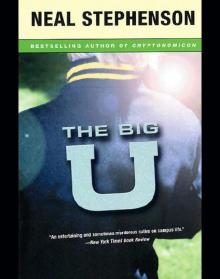 The Big U
The Big U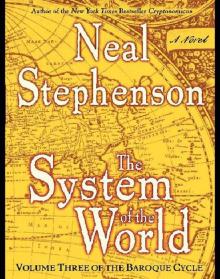 The System of the World: Volume Three of the Baroque Cycle
The System of the World: Volume Three of the Baroque Cycle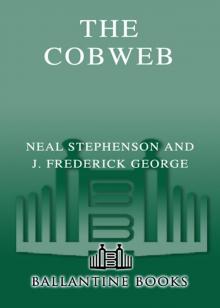 The Cobweb
The Cobweb Reamde
Reamde Fall; or, Dodge in Hell
Fall; or, Dodge in Hell Interface
Interface Quicksilver
Quicksilver The Mongoliad: Book Three
The Mongoliad: Book Three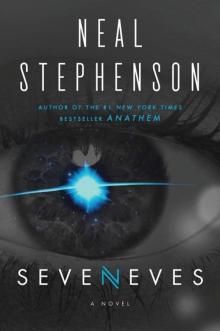 Seveneves
Seveneves Atmosphæra Incognita
Atmosphæra Incognita In the Beginning...Was the Command Line
In the Beginning...Was the Command Line Anathem
Anathem The Rise and Fall of D.O.D.O.: A Novel
The Rise and Fall of D.O.D.O.: A Novel The Mongoliad: Book Two
The Mongoliad: Book Two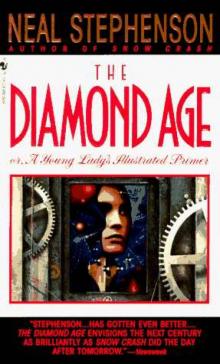 Diamond Age or a Young Lady's Illustrated Primer
Diamond Age or a Young Lady's Illustrated Primer THE System OF THE WORLD
THE System OF THE WORLD The Mongoliad: Book One tfs-1
The Mongoliad: Book One tfs-1 Some Remarks: Essays and Other Writing
Some Remarks: Essays and Other Writing Zodiac
Zodiac Spew
Spew The Baroque Cycle: Quicksilver, the Confusion, and the System of the World
The Baroque Cycle: Quicksilver, the Confusion, and the System of the World The Diamond Age
The Diamond Age Reamde: A Novel
Reamde: A Novel In the Kingdom of Mao Bell
In the Kingdom of Mao Bell Mother Earth Mother Board
Mother Earth Mother Board Twelve Tomorrows - Visionary stories of the near future inspired by today's technologies
Twelve Tomorrows - Visionary stories of the near future inspired by today's technologies The Confusion
The Confusion The Great Simoleon Caper
The Great Simoleon Caper The Mongoliad: Book Three tfs-3
The Mongoliad: Book Three tfs-3